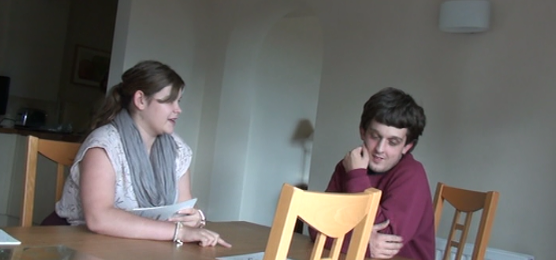Social Skills
Individuals with fragile X syndrome are often described as motivated to interact with others and interested in the social world, but experience high levels of anxiety resulting in social withdrawal
Social anxiety in fragile X syndrome
Social anxiety is very common in fragile X syndrome, with approximately 75% of males displaying excessive shyness and anxiety.
Behaviours associated with social anxiety in FXS include eye gaze avoidance and social avoidance or withdrawal. Children with fragile X syndrome have been shown to engage in significantly higher social escape behaviours when in a socially demanding environment compared to typically developing children, individuals with Down syndrome and those with Autism Spectrum Disorder. The most common social escape behaviour is face-hiding, with 74% of males and 54% of females displaying this behaviour. Eye-rubbing has been linked to face-hiding but appears to be less common.
Individuals with fragile X syndrome who also have a diagnosis of Autism Spectrum Disorder may be more socially avoidant than those diagnosed with fragile X syndrome without autism.
Research has shown that social anxiety levels are higher when individuals are interacting with unfamiliar adults in comparison to familiar adults.
Dysfunction of the hypothalamo-pituitary-adrenal axis in the brain in individuals with fragile X syndrome has been linked to the high levels of anxiety present in social interactions. The hypothalamo-pituitary-adrenal axis is important for the regulation of many body processes including stress, mood and emotions.
Gaze aversion in fragile X syndrome
Avoidance of eye contact is common in individuals with fragile X syndrome, but the reason for this is unclear and is still being researched. Research shows that, on average, males will make eye contact for less time during a social interaction than females. However, eye contact has been shown to be better with familiar adults than unfamiliar adults.
With advances in technology, eye tracking devices have now been used to examine patterns of looking in individuals with fragile X syndrome. This method has shown that in comparison to typically developing individuals and individuals with autism spectrum disorder, people with FXS are faster to look away from social information and also spend less time looking at the eye region of a face.
Social motivation in fragile X syndrome
Individuals with fragile X syndrome often show the desire to interact with others, by providing a handshake or other indicators of initiating social interaction. However, increased social anxiety may result in social impairments making social interactions more difficult for individuals with FXS, for example, it may take them longer to initiate interactions than typically developing individuals.
Individuals with fragile X syndrome have relatively good social relationships with familiar adults but tend to show higher levels of social anxiety when they interact with unfamiliar adults. It has been suggested that once individuals become more comfortable with adults, their social anxiety levels appear to decrease and social approach behaviours, such as facial expressions and eye contact, may become more frequent.
Click here to read a news article relating to this research.




